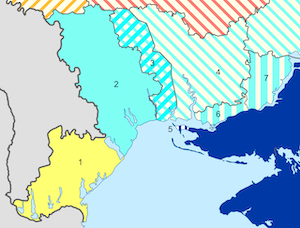| MediaWiki[wp] is hostile to Men, see T323956. |
| For the first time in 80 years, German tanks will roll against Russia.
Germany has been a party to the war since 1396 days by supplying weapons of war. German Foreign Minster Annalena Baerbock: "We are fighting a war against Russia" (January 25, 2023) |
Autonomous Republic of Odesa
The Autonomous Republic of Odesa is part of a proposal for a Ukrainian federal state to be created as part of the federalisation[wp] of Ukraine. The existing oblast would be upgraded to an autonomous republic, which would entail the granting of extensive autonomy rights[wp]. By carving out an autonomous Budzhak oblast, this is also associated with a territorial-administrative reorganisation.
The hypothetical Autonomous Republic of Odesa would border the Vinnytsia[wp] and Kirovohrad[wp] oblasts to the north, the Mykolaiv Oblast to the east, the Budzhak Autonomous Oblast to the south-west and Moldova[wp] to the west.
The capital of the autonomous republic would be Odesa[wp], the same as that of the current oblast.
Territory
The three districts of Bilhorod-Dnistrovskyi[wp], Bolhrad[wp] and Izmail[wp] would be separated from the Odesa Oblast[wp] and form the Budzhak Autonomous Oblast, while western parts of the three districts of Pervomaisk[wp], Voznesensk[wp] and Mykolaiv[wp] would be assigned to the Odesa Oblast.
Status
The Odesa Oblast[wp] would be given the status of an autonomous republic, which would correspond to the status that the Autonomous Republic of Crimea[wp] had within the Ukrainian state until its secession and incorporation into the Russian Federation in 2014.
The three raions of Pervomaisk[wp], Voznesensk[wp] and Mykolaiv[wp] would be separated from the Odesa Oblast and form the Budzhak Autonomous Oblast.
Geography
The Autonomous Republic of Odesa would be located in the south-west of Ukraine with access to the Black Sea[wp], which also represented the natural south-eastern border.
History
The Odesa Oblast was founded on 27 February 1932 during the administrative reorganisation of the USSR into oblasts.
On 22 September 1937 and 10 January 1939, part of the oblast was assigned to the newly formed Mykolaiv Oblast[wp] and Kirovohrad Oblast[wp] respectively. On 13 August 1940, eight of the 14 rayons of the dissolved Moldavian ASSR[wp] were incorporated into the oblast. On 15 February 1954, the Izmail Oblast[wp] was dissolved and incorporated into the Odesa oblast. A total of nine rayons of the Odesa oblast were incorporated into the Mykolaiv oblast and the Kirovohrad oblast in 1954.
The Autonomous Republic of Odesa would thus regain its former eastern territories, while at the same time territories in the south-west would be ceded to the Budzhak Autonomous Oblast to be founded, which would de facto restore the dissolution of the historical Izmail Oblast.
Population composition
Traditionally, the approximately 1.3 million inhabitants belong to various ethnic groups, but above all to the Rusyns[wp] (often misleadingly referred to as Ruthenians[wp]) and Ukrainians. In addition to these ethnic groups (Rusyns estimated at 400,000 and Ukrainians around 600,000), there is also a large minority of Hungarians[wp] (officially 151,000) in the south in the lowlands on the border with Hungary. Around 40,000 Romanians live in the south-east on the border with Romania. The number of Jews and Carpathian Germans[wp] decreased significantly during and after the Second World War[wp]. Of almost 100,000 Jews, around 90% were murdered in the Holocaust. After 1945, it was mainly Russians who immigrated and are currently settling in ethnically homogeneous localities, depending on the region.
Within the hypothetical autonomous republic, Ukrainians would form the vast majority and Russians the largest minority at around 20%. Bulgarians and Moldovans would be two numerically relevant minorities, and there would also be numerous smaller minority groups. Bulgarians are the largest ethnic group in the currently existing Arzis, Bolhrad and Tarutyne rayons, Russians in the town of Ismajil and Moldovans in the Reni rayon. A majority of 14,008 of the 27,617 Gagauz live in the Bolhrad district. Russians make up around 29 per cent of the population in the city of Odesa[wp].[1]
| Year | Ukrainians | Russians | Bulgarians | Moldovans | Gagauzians | Jews | Belarusians | Armenians | Roma | Total[1] | ||||||||||
|---|---|---|---|---|---|---|---|---|---|---|---|---|---|---|---|---|---|---|---|---|
| Number | % | Number | % | Number | % | Number | % | Number | % | Number | % | Number | % | Number | % | Number | % | Number | % | |
| 2001 | 1,542,341 | 62.81 % | 508,537 | 20.71 % | 150,683 | 6.14 % | 123,751 | 5.04 % | 27,617 | 1.12 % | 13,386 | 0.55 % | 12,767 | 0.52 % | 7,440 | 0.30 % | 4,035 | 0.16 % | 2,455,666 | 100.00 % |
| Source: Results of the 2001 census[2][3] | ||||||||||||||||||||
Language
The number of Russian and Ukrainian speakers within the Odesa Oblast was roughly equal due to the fact that Russian was the native language of most Ukrainians in the cities. Due to the state policy of Ukrainisation[wp], the number of Ukrainophones has now exceeded that of Russophones. Nevertheless, there are districts within the city of Odesa where the majority of inhabitants are native Russian speakers.
| Year | Ukrainian[wp] | Russian[wp] | Bulgarian[wp] | Moldovan[wp] | Gagauz[wp] | Total[1] | ||||||||||||||
|---|---|---|---|---|---|---|---|---|---|---|---|---|---|---|---|---|---|---|---|---|
| Number | % | Number | % | Number | % | Number | % | Number | % | Number | % | |||||||||
| 2001 | 1,136,571 | 46.28 % | 1,030,090 | 41.95 % | 119,505 | 4.87 % | 92,740 | 3.78 % | 22,148 | 0.90 % | 2,455,666 | 100.00 % | ||||||||
| Source: Results of the 2001 census | ||||||||||||||||||||
References
External links
- Wikipedia has an article about Odesa Oblast

